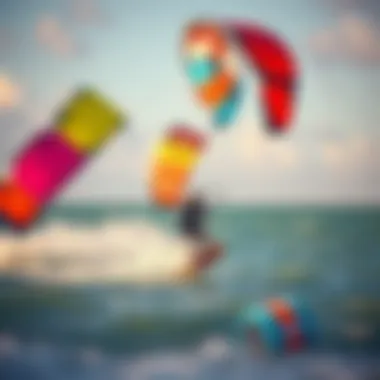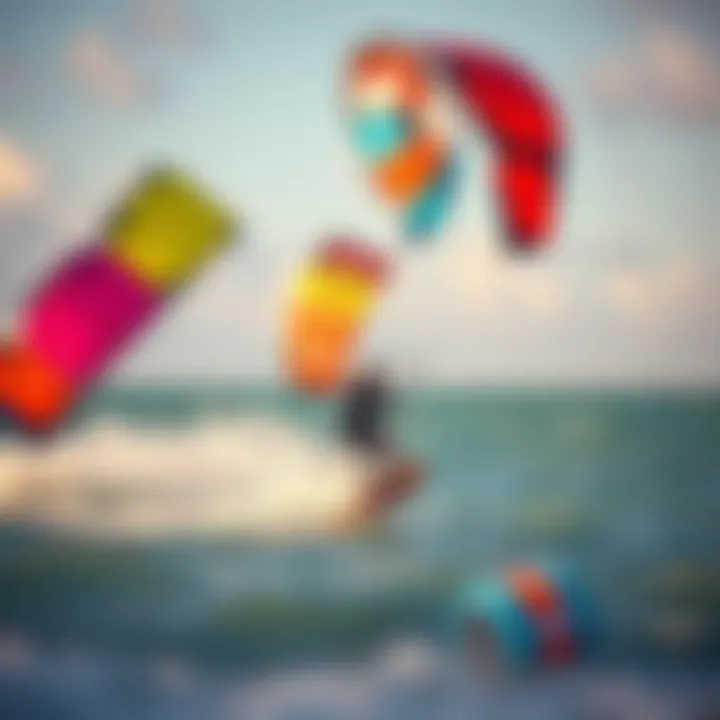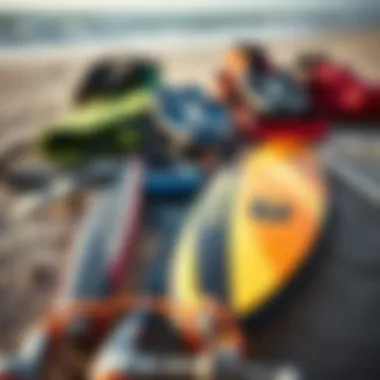Kiteboarding on South Padre Island: A Comprehensive Guide


Intro
Kiteboarding has gained momentum as a thrilling water sport that seamlessly blends elements of surfing, windsurfing, and wakeboarding. For thrill-seekers and relaxation aficionados alike, South Padre Island serves as an ideal backdrop for this exhilarating activity. Nestled along the Gulf Coast of Texas, the island boasts idyllic weather, steady winds, and expansive beaches that cater to riders of all skill levels. Whether you're a seasoned pro or just dipping your toes into the kiteboarding world, there's something here for everyone.
This guide aims to walk you through the essentials of kiteboarding in South Padre Island. From gearing up with the right equipment to tips on enhancing your technique, all the way to understanding local culture and safety practices, we’ve got you covered. After all, a good adventure is one where you're well-prepared.
Gear and Equipment
Before you hit the water, having the right equipment can make a world of difference in your experience. Kiteboarding gear isn't just about looking good; it affects your performance and safety.
Essential Kiteboarding Gear for Beginners
For those just starting out in kiteboarding, it's crucial to have basic gear that provides both safety and ease of use. Here are some essentials:
- Kite: Your kite is the heart of your setup. For beginners, a larger kite provides more lift and stability. Look for user-friendly models from brands like North or Cabrinha.
- Board: A twin-tip board is the most common choice for beginners. It allows for smoother rides and easier transitions.
- Harness: A comfortable harness can prevent fatigue. Choose one that fits well and supports your back effectively.
- Safety Leash: This is critical for quick release in case you need to detach from your kite.
- Helmet and Impact Vest: Protecting yourself when learning to kiteboard is non-negotiable. A helmet and a protective vest can safeguard against falls.
Advanced Equipment for Experienced Riders
Once you've conquered the basics, you might want to upgrade your gear. Bigger, more specialized equipment can greatly enhance performance:
- High-Performance Kite: As you gain confidence, consider investing in a kite designed for specific styles, like freestyle or wave riding.
- Wave Board: If riding waves is your passion, you'll want a board optimized for that category.
- Carbon Fiber Fins: These can significantly enhance speed and maneuverability.
Techniques and Tips
Kiteboarding is not only about the gear; mastering the art of riding requires skill and practice. Here are some essential techniques and tips to keep in mind:
Safety Practices for Kiteboarding
Safety should be your top concern, especially for beginners. Remember the following:
- Always check the weather and wind conditions before heading out.
- Stay clear of crowded areas. Giving others space helps to prevent accidents.
- Learn how to perform a self-rescue. It’s a vital skill that can come in handy.
*"Preparation is key to ensuring not just your own safety, but also that of others on the water."
Training Techniques to Improve Your Skills
To continuously improve your kiteboarding skills, consider these methods:
- Take Lessons: Getting guidance from a certified instructor can accelerate your learning process.
- Practice Regularly: Like any sport, consistent practice is essential. Aim to ride as often as you can.
- Video Analysis: Recording your sessions can provide insights that help locate areas for improvement.
Ultimately, kiteboarding on South Padre Island can be a remarkable experience rooted in adventure, community, and personal growth. Preparing adequately enhances not just your time on the water, but also your enjoyment of this exhilarating sport.
Foreword to Kiteboarding
Kiteboarding has become one of the most thrilling water sports, combining the adrenaline of surfing with the grace of flying a kite. It’s not just a pastime; it’s a lifestyle for many who seek the freedom of gliding over water, harnessing the wind to propel themselves. Understanding kiteboarding is essential for anyone looking to enhance their experience, especially in a prime location like South Padre Island.
Origin and Evolution of Kiteboarding
Kiteboarding’s roots can be traced back to the 1970s when windsurfing enthusiasts started experimenting with kites. Over the decades, the sport has evolved significantly. Initially, the equipment was rudimentary; it was just a matter of connecting a surfboard with a kite and hoping for the best. Fast forward to today, and we’ve got sophisticated designs, like inflatable kites and boards tailored for beginners to experts alike. The fusion of sports—surfing, snowboarding, and wakeboarding—has shaped the techniques and styles in kiteboarding, catering to all types of thrill-seekers. And it isn't just about the ride; it’s about the community, the competitions, and the sheer joy of mastering the winds.
The Appeal of Kiteboarding
What makes kiteboarding so captivating? For starters, it offers a unique blend of athleticism and artistry. Kiteboarders harness the power of the wind to maneuver through the waves, executing tricks that can be as mesmerizing as they are challenging. The sense of freedom this sport provides can only be described as exhilarating.
Moreover, kiteboarding is accessible to a wide audience; you don’t need to be a professional athlete to enjoy the thrill. With proper instruction and safety measures in place, even beginners can share in the excitement. As you progress, there’s always something new to learn or a boundary to push, keeping the sport fresh. Also, the stunning backdrop of South Padre Island—the blend of turquoise waters and sunny skies—only enhances the experience.
"Kiteboarding is not just a sport; it’s a connection to nature, and the perfect blend of challenge and beauty."


In summary, kiteboarding is about much more than just riding the waves. It serves as a gateway to both personal growth and community building. Whether you are a novice eager to dip your toes or an experienced kiteboarder seeking new challenges, understanding the art and science behind kiteboarding can profoundly enrich your engagement with this spectacular sport.
South Padre Island: A Kiteboarding Paradise
When it comes to kiteboarding, South Padre Island stands out as a premier destination. The island’s geographical attributes, combined with its favorable climate and dynamic wind patterns, create a haven for both seasoned pros and newcomers eager to test the waters. The very essence of the sport thrives here, drawing kiteboarders from all corners, enhancing camaraderie and a sense of community within this vibrant outdoor-space.
Geographical Overview
Nestled along the Gulf of Mexico, South Padre Island offers a unique blend of natural beauty and strategic advantages for kiteboarding. The island stretches approximately 34 miles long and is just a stone's throw from the coastline, providing ample space for enthusiasts to practice. One of its most significant geographic features is the expansive, shallow waters of the Laguna Madre Bay – perfect for learning and practicing maneuvers without the daunting waves often found in the open sea.
The sandy beaches and shallow flats offer a variety of playing fields that cater to different skill levels. Additionally, the proximity to the shoreline means that kiteboarders can easily access the water, which is often a treasure when dealing with cumbersome gear.
Climate and Wind Patterns
The climate on South Padre Island adds to its kiteboarding allure. With an average temperature fluctuating from mild winters to warm summers, the weather is mostly sunny. However, what truly sets this destination apart is its consistent wind patterns. From late spring to early fall, the island enjoys steady winds ranging from 15 to 30 knots, which are ideal for kiteboarding.
Wind gusts are typically more gentle in the mornings and pick up throughout the afternoon. This rhythm allows beginners to practice in calmer conditions before the winds really kick in—making it a favorable spot to transition from novice to experienced rider.
It is crucial for kiteboarders to check local weather forecasts regularly, as unpredictable weather systems can influence wind conditions unexpectedly.
Key Kiteboarding Locations on South Padre Island
Choosing the right spot to kiteboard is akin to finding the sweet spot in a game of golf or discovering that undiscovered gem for a much-loved weekend getaway. It can make a world of difference not just in terms of skill progression but also in enjoyment and safety. On South Padre Island, the geography and climate come together to form a veritable playground for kiteboarders. From shallow waters perfect for beginners to challenging waves that cater to the more seasoned adventurers, the locale has something for everyone.
The significance of knowing the key kiteboarding locations is paramount for anyone looking to harness the wind and surf. These sites provide various conditions—such as wind, water depth, and wave size—that can affect the kiteboarding experience profoundly. A good spot can enable enthusiasts to hone their skills in a safe environment while offering someone more advanced the opportunity to test new maneuvers or tricks. Furthermore, a good understanding of these key locations fosters a better culture among local kiteboarders and newcomers alike.
Best Spots for Beginners
For those just starting out in kiteboarding, choosing the right spot can be the difference between frustrating flat water experience and a smooth ride on the waves. South Padre Island offers several locations that are specifically tailored for newbies.
One major spot popular among beginners is the area near the South Padre Island Convention Centre. This locale boasts shallow waters, which allows beginners to practice their technique without the daunting depths of the ocean. Moreover, the presence of sandbars provides ideal launching conditions.
Another excellent choice is Schlitterbahn Beach Resort. This spot not only offers a safe environment for those first learning the ropes, but it provides instruction from certified professionals, ensuring that newcomers embark on their kiteboarding journey with the appropriate guidance. The calm waters there allow beginners to get acquainted with their gear without feeling overwhelmed.
Advanced Kiteboarding Areas
Once the basics have been mastered, kiteboarders often seek out more challenging conditions. South Padre Island does not disappoint with a variety of spots that cater to those looking to push the envelope.
The Waves at the Kitelite are a prime destination for more experienced riders who crave some action. Located on the Gulf side, this area is known for its consistent wind conditions and larger waves, making it ideal for jumping and performing tricks. Riders here need to be mindful, especially of boat traffic and stronger currents, but overcoming these challenges is what makes this place a favorite among seasoned kiteboarders.
Additionally, the North Flat area is one more location that attracts advanced kiteboarders. This site offers flat water with chop, providing an exceptional environment for speed and various turns. The local kiteboarding community often gathers here to train and show off new tricks, adding to the vibrant atmosphere of the area.
Hidden Gems: Lesser-Known Locations
While South Padre Island has its well-known kiteboarding spots, the thrill of discovering hidden gems can be immensely rewarding for passionate riders.
One such spot is the End of the Road at the southern tip of the island. This relatively secluded stretch promises stunning views and cleaner winds due to its distance from the bustling main areas. It's also less crowded, which allows kiteboarders to enjoy a more serene experience.
Another lesser-known location is Isla Blanca Park. Although gaining more recognition, it can still offer quieter sessions compared to high-traffic areas. The park often has favorable wind conditions, making it ideal for those looking to ride without the constant buzz of other kiteboarders around. The parks help maintain the environment, ensuring that kiteboarding has sustainability long into the future.
Whether you're just starting out or you're looking to refine your skills, the kiteboarding locations on South Padre Island offer a variety of choices. It's about making sure the right environment matches your skill level, allowing you to enjoy everything this beautiful destination has to offer.
Essential Gear for Kiteboarding
Kiteboarding is not just a thrilling sport; it’s an entire experience that brings together adrenaline, nature, and skill. Having the right gear is crucial to fully enjoy what kiteboarding has to offer. The kite acts as your engine, your board translates that power into speed, and your harness ensures you’re correctly connected to it all. This section dives deep into the essentials you’ll need to get started, and why each element is important.
Kites: Types and Features


When it comes to kites, there’s a significant variety that one can choose from. Different kites adapt to specific wind conditions and user preferences. Here’s a quick overview:
- C-Kites: These are the classic shapes, known for their immediate power and strong pop. Best for experienced riders wanting more control.
- Bow Kites: With a flatter shape, they provide a huge wind range and easy relaunch, making them suitable for learners.
- Delta Kites: They combine features of C-kites and Bow kites, known for their stability and performance.
Each kite comes with unique features completing the package, such as modular bridle systems or varying aspect ratios. The shape influences how quickly the kite responds to input, making some kites more forgiving for beginners, while others cater to the skilled. It’s essential to consider your skill level when choosing a kite. Whether you prefer boosting jumps, speed runs, or just cruising, the right kite plays a key role in your kiteboarding adventure.
Boards: Choosing the Right One
Selecting the right board is a bit like choosing the right shoes for a hike. It's pivotal to your comfort and performance on the water.
- Directional Boards: Best for surfers who want to ride the waves. They look quite similar to surfboards.
- Twin-Tip Boards: Compatible for all riders, they’re symmetrical, allowing you to ride in either direction which is especially helpful for newcomers.
- Freestyle Boards: Designed for tricks and aerial maneuvers; they’re typically lighter and sometimes slightly stiffer.
You should also consider the board size based on your weight, skill level, and intended style. A larger board grants added stability, perfect for those starting. In contrast, smaller boards facilitate performance but require more skill to manage.
Harnesses and Safety Equipment
The harness is the heart of your control, connecting you securely to the kite. There are a couple of main types:
- Waist Harnesses: Favored by freestylers for mobility, they sit around your waist with lines attaching to the kite.
- Sit Harnesses: Great for new kiteboarders, they provide extra support and stability, especially in heavy winds.
However, safety gear can’t be overlooked. A helmet and impact vest can matter greatly in case of falls. Sometimes, a safety leash can keep equipment close if you lose grip. Ensure it’s all properly fitted and in good condition before hitting the waves. A good rule of thumb? Always prioritize safety and invest in quality equipment.
"Safety first. It’s better to be overprepared than underprepared."
All in all, gear selection is more than just aesthetics; It directly impacts performance, enjoyment, and safety. Equip yourself wisely before riding the waves of South Padre Island.
For further information and discussions on kiteboarding gear, check out resources like Kiteboarding Wiki or join communities at Reddit.
This is your go-to guide for understanding the essentials to kiteboarding gear, which ultimately enriches your water sport adventures.
Safety Measures in Kiteboarding
Safety measures are the backbone of any extreme sport, and kiteboarding is no exception. Whether you’re a seasoned kiteboarder or just getting your feet wet, understanding and practicing safety protocols can save lives and make every ride a joy instead of a worry. As you hit the winds on South Padre Island, knowing the ins and outs of safety can enhance not just your experience but also your confidence.
Understanding Weather Conditions
One of the critical factors influencing the safety of kiteboarding is the weather. Kiteboarders need to be well-aware of the atmospheric conditions before heading out. For the uninitiated, weather conditions can change rapidly, especially around coastal regions like South Padre Island. Here are some elements to keep in mind:
- Wind Speed and Direction: Ideal wind speeds for kiteboarding generally range between 12 to 25 knots. Stronger winds can be risky, particularly for beginners. Knowing how to read wind direction can also help you choose the right spot to launch. South Padre has a variety of wind patterns, so it’s worth learning how they behave.
- Current and Tides: The water currents on South Padre Island vary with the tides, which can affect your ride. High tides may limit your riding area, while low tides can expose rocks and debris. Make sure to consult local tide charts before heading out.
- Storm Warnings: Always check for weather warnings. Sudden storms can brew up, leading to dangerous wave conditions and gusty winds. When in doubt, it’s wiser to sit it out.
- Temperature: Cold weather can decrease your body's ability to react quickly. It’s smart to know your limits and to dress appropriately. Hypothermia is nothing to mess around with, especially when you're wet.
Establishing a habit of checking the weather will go a long way in keeping your kiteboarding adventures safe. Various apps can help you get accurate updates about wind configurations and other meteorological parameters.
“The single most important part of kiteboarding is understanding the weather. Without the right conditions, even the best gear won’t save you.”
Essential Safety Practices
In addition to understanding the weather, adopting certain safety practices will significantly enhance your kiteboarding experience. Here are some practices worth integrating into your routine:
- Pre-Flight Check: Inspect your gear before launching. This means checking lines for frays, making sure your kite inflates properly, and that your board's straps are secure.
- Use Proper Gear: Having the right equipment can make all the difference. A well-fitted harness and quality leash can reduce the risk of injuries if things go awry.
- Buddy System: Whenever possible, kiteboard with a partner. Having someone there can be invaluable for spotting potential hazards and providing assistance when needed.
- Know Your Limits: If you're a beginner, don’t push yourself too hard. Gradually build your skills and confidence instead of tackling challenging waves right off the bat.
- Emergency Plan: Always have an action plan for emergencies. Whether that means signaling for help or using a safety release mechanism, knowing what to do can save you in unexpected situations.
- Take Lessons: If you're new, enroll in kiteboarding lessons. A qualified instructor can teach you both techniques and safety guidelines that will serve you well into the future.
In summary, kiteboarding can be exhilarating, but without appropriate safety measures, it can quickly turn dangerous. By educating yourself about the specific conditions of South Padre Island and practicing essential safety routines, you set yourself up for many successful and safe adventures on the waves.
Techniques for Kiteboarders
Understanding different techniques in kiteboarding is vital not only for mastering the sport but also for ensuring the safety and enjoyment of one’s experience on the water. Techniques serve as the building blocks for achieving proficiency in kiteboarding, whether it’s for leisure or competition. For newcomers, mastering the basics can foster confidence, while those with more experience can refine their skills to tackle advanced maneuvers. Furthermore, learning about kiteboarding techniques allows individuals to effectively interact with the environment, adapting to varying conditions on South Padre Island. Here, we will break down essential skills to help kiteboarders elevate their ability and deepen their engagement.
Basic Maneuvers for Newcomers


For those just entering the realm of kiteboarding, grasping the fundamental maneuvers is crucial. Basic techniques not only make kiteboarding enjoyable but also help learners progress safely through their initial experiences. Here are some key moves that newbies should focus on:
- Launching and Landing the Kite: Getting the kite into the air is the first hurdle. It’s essential to understand how to safely launch and land, typically with the help of a buddy. Positioning the kite at the right angle relative to the wind is critical to take-off.
- Sitting Position and Balance: While on the board, it's vital to keep a low center of gravity. Bending your knees and leaning back while maintaining an upright posture can save you from wipeouts.
- Basic Turns: Learning to steer is the first step towards navigating the waters. Face your hips in the intended direction along with shifting your weight. Mastering toe-side and heel-side turns will give you better control and comfort.
- Straight Riding: Ultimately, simply riding straight can be a challenge at first. Focus on keeping the kite steady in the neutral position to maintain speed. Practice makes perfect, so do not hesitate to spend time on this.
By honing these basic maneuvers, beginners can ensure they establish a strong foundation upon which their skills can develop further.
Advanced Techniques for Experienced Riders
For those who have mastered the fundamentals, advanced techniques allow for a greater expression of skill and creativity on the water. Experienced kiteboarders often seek out more complex maneuvers to challenge themselves and enhance their rides. Some advanced techniques worth diving into include:
- Jumping: This iconic move involves getting air by pulling hard on the back hand and edging the board. Timing is everything, so mastering the jump can take persistence.
- Kite Loops: Executing a kite loop is both thrilling and risky. By pulling down on the front of the kite while in the air, a loop is created. It requires precise control and experience, but can create exhilarating moments on the water.
- Handle Passes: This advanced trick involves passing the kite handle behind your back while airborne. It adds a stylish flair to jumps and requires strong body control and timing.
- Unhooked Tricks: Unhooking from the harness strap opens the door to a list of maneuvers that spark excitement. This technique requires significant skill as it alters the center of balance and necessitates improved kite awareness.
"Kiteboarding is not just a sport; it’s a chance to express oneself against the backdrop of nature. Embrace each technique as an art form."
These advanced techniques not only showcase a kiteboarder’s skills but also enhance the overall riding experience.
Kiteboarding on South Padre Island offers unique challenges and opportunities within its ideal conditions. Mastering a range of techniques can significantly improve a kiteboarder’s confidence and performance, providing an edge when participating in local events or simply enjoying the ocean’s splendor. Full engagement with the sport allows practitioners to forge connections with the vibrant kiteboarding community around South Padre Island.
Kiteboarding Community and Culture
Kiteboarding is not just a sport; it’s a way of life for many enthusiasts, especially on South Padre Island. This vibrant community thrives on shared experiences, from novices taking their first flights to seasoned riders pushing the limits of the sport. In this section, we’ll explore the significance of community and culture in kiteboarding, looking at the local events that bring people together and the connections formed among kiteboarders.
Local Events and Competitions
Events on South Padre Island celebrate the spirit of kiteboarding while fostering a sense of camaraderie among riders. Locals and visitors alike gather for competitions that range from friendly contests to serious tournaments. These gatherings not only showcase skills but also encourage the exchange of techniques, tips, and trends. Some notable events include:
- Kiteboarding World Championship: A premier event attracting top talent from around the globe. Participants tackle challenging wind conditions, and spectators enjoy thrilling aerial acrobatics.
- Local Kite Festivals: These events are perfect for beginners to intermingle with experienced riders, often featuring workshops and demos. It’s a fantastic opportunity for newcomers to learn about the craft and for veterans to brush up on their skills.
Participating in these events fosters friendships that often extend beyond the water. It’s about more than just the competition; it’s about building a supportive network where everyone contributes to the growth of the sport. As a result, riders feel encouraged to push their boundaries and explore new techniques, ensuring the culture of kiteboarding continues to thrive.
Networking with Other Kiteboarders
Networking is another crucial facet of kiteboarding culture on South Padre Island. Whether it’s sharing a meal at a beachside bar or discussing strategy during a break, connections made on the water can lead to lifelong friendships and collaborations. The kiteboarding community is known for its inclusivity, where riders share resources, gear, and advice freely, creating an environment that nurtures development. Here are some avenues for networking:
- Social Media Groups: Platforms like Facebook and Reddit host various kiteboarding groups where enthusiasts share stories, advice, and organize meetups. Engaging in these groups can help you find riding partners or learn about local happenings.
- Surf Shops and Schools: These are not just places to rent equipment; they often act as community hubs. Instructors and riders gather here, forming connections that can lead to future collaborations and friendships.
- Kiteboarding Retreats: Participating in retreats can be an enriching experience. These events allow riders from different backgrounds to come together for lessons, competitions, and shared interests, greatly enhancing the community feel.
By networking with others in the kiteboarding scene, riders can over time help each other advance in skill level and amplify their shared love of the sport. These bonds often translate into a thriving community that acts as a solid support system, ensuring everyone enjoys the ride — both on and off the water.
“Kiteboarding is about more than the thrill of the sport; it's about the community that lifts you up and the waves you ride together.”
In essence, the culture surrounding kiteboarding on South Padre Island emphasizes collaboration, skill development, and forming connections that enhance the kiteboarding experience for everyone involved. As the sport continues to grow, so does the community, making it an integral part of what kiteboarding represents in this unique locale.
Closure and Future of Kiteboarding in South Padre Island
The sport of kiteboarding has carved itself a recognizable niche in the recreational landscape of South Padre Island, creating a vibrant community focused on adventure and connection. As we examine the current state and envision the future of kiteboarding here, it’s essential to consider the involvement of local organizations, the impact of tourism, and the importance of sustainability practices.
Sustainability Practices in Kiteboarding
Embedding sustainability into kiteboarding practices is becoming increasingly vital, not only for the local ecosystem but also for the sport's longevity. As more kiteboarders flock to South Padre Island, the interaction with nature intensifies. This connection calls for responsible behavior, like adhering to leave-no-trace principles. Kiteboarders can actively engage in maintaining pristine environments by sticking to designated areas and minimizing their effect on wildlife.
Additionally, educational programs aimed at kiteboarding enthusiasts can play a crucial role in fostering a culture of sustainability. Workshops highlighting eco-friendly practices, such as using recyclable materials for gear and reducing plastic waste, are essential small steps that can lead to greater changes. Programs designed to raise awareness of the impact of climate change on wind patterns and sea levels are also recommended. These educational efforts not only promote responsible kiteboarding but also build a tighter-knit community among enthusiasts who share a passion for both the sport and the environment.
The Growth of Kiteboarding Popularity
The excitement surrounding kiteboarding on South Padre Island shows no signs of slowing down. Its burgeoning popularity can be attributed to several factors. First and foremost, the island's unique geographical features present ideal conditions for riders of all skill levels. The combination of steady winds and flat waters creates a playground that lures beginners and seasoned athletes alike.
Social media platforms significantly contribute to this growth, with stunning visuals of kiteboarding stunts and breathtaking scenery encouraging people to try their hand at it. From Instagram reels to TikTok challenges, the sport's visibility has skyrocketed in recent years. Festivals and competitions held on the island further amplify this interest, drawing crowds and participants from afar.
Looking forward, kiteboarding has the potential to expand its reach even more. Engaging local schools, offering youth programs, and creating partnerships with eco-conscious brands could help the sport reach a broader audience. The buzz is palpable, and the future of kiteboarding here looks bright. It isn’t just about riding the wind; it’s about community, environmental awareness, and cultivating an enduring legacy that future generations can enjoy.
"Kiteboarding is more than a sport; it's a way to connect with nature and each other. Striving for sustainability ensures that future riders can experience the same joy that we have today."
In sum, as kiteboarding grows in popularity on South Padre Island, its practitioners must embrace sustainability to protect the very element that fuels their passion - the wind and the sea.



